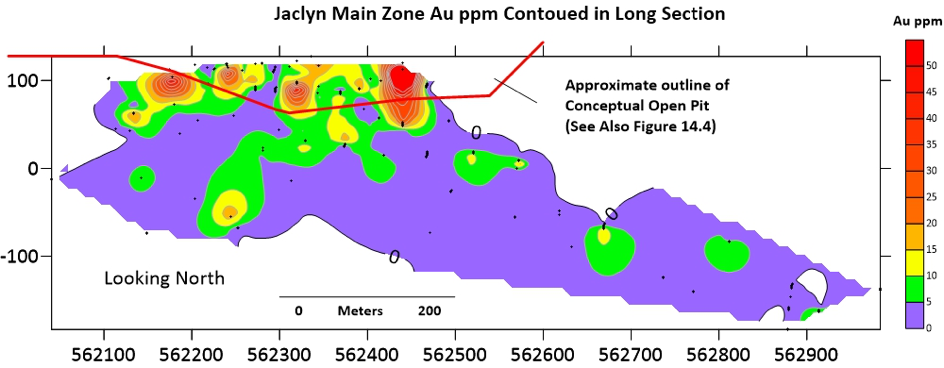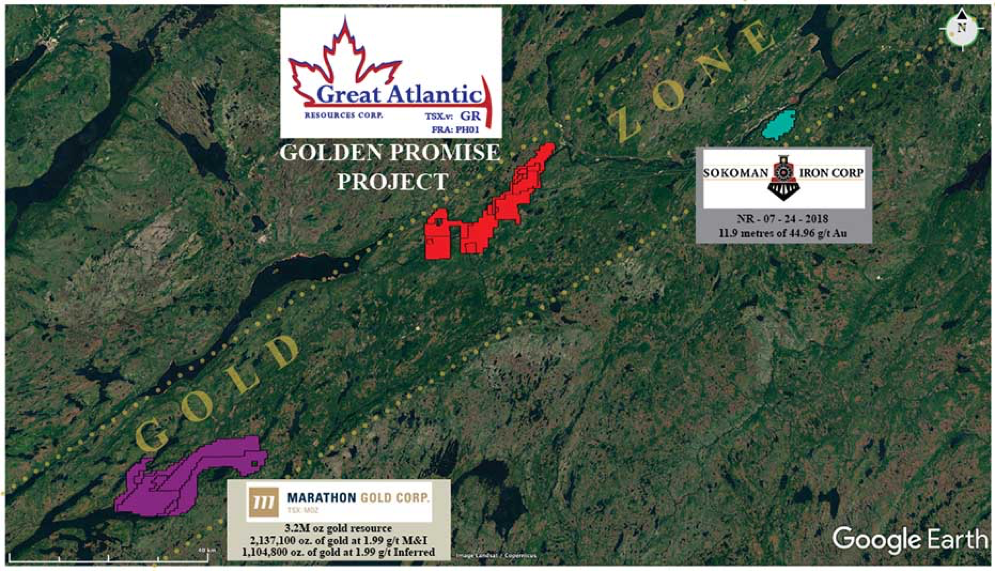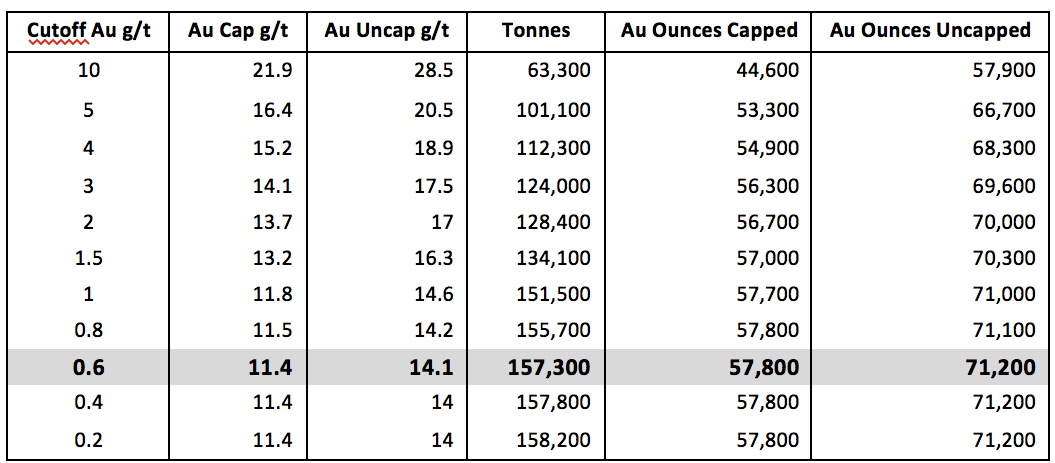Great Atlantic Resources Corp. Files 43-101 Report on Golden Promise Project, Newfoundland
Great Atlantic Optionee Completes Diamond Drilling Program At Porcupine Base Metal – Precious Metal – REE Property Central New Brunswick
November 8, 2018Co-Mn Base Metals Project, New Brunswick
December 18, 2018(TSXV : GR)
(FRA: PH01)
Great Atlantic Resources Corp. Files 43-101 Report on Golden Promise Project, Newfoundland
VANCOUVER, British Columbia – December 6, 2018 – GREAT ATLANTIC RESOURCES CORP. (TSXV.GR) (the “Company” or “Great Atlantic”) announces that it has received and filed on SEDAR a National Instrument 43-101 Technical Report, dated December 4, 2018 (revising a previous filed version dated November 28, 2018) (the “Report”) on the Company’s Golden Promise Gold Property, located in the central Newfoundland gold belt. The report was completed by Mr. Greg Z. Mosher, M.Sc. App., P.Geo., and Mr. Larry Pilgrim, B.Sc., P.Geo. The amendments in the December 4 version of the technical report principally relate to disclosure of QA/QC programs in Part 11 and data verification in Part 12. The material conclusions of both versions of the Report are the same.
The Report includes the following mineral resource estimate (Inferred resources) for the Jaclyn Main Zone, the maiden resource estimate for the Company on the property:
The Golden Promise Property hosts multiple gold bearing quartz veins and is located in a region of recent significant gold discoveries. The property is located within the Exploits Subzone of the Newfoundland Dunnage Zone. Within the Exploits Subzone, the property lies along the north-northwestern fringe of the Victoria Lake Supergroup (VLSG), a volcano-sedimentary terrane. The northwestern margin of the Golden Promise Property occurs proximal to, and, in part, contiguous with a major (Appalachian-scale) collisional boundary, and suture zone, known as the Red Indian Line (RIL). The RIL forms the western boundary of the Exploits Subzone. Recent significant gold discoveries in this region of the Exploits Subzone include those of Sokoman Iron Corp. (TSXV.SIC) at the Moosehead Project and Marathon Gold Corp. (TSXV.MOZ) at the Valentine Lake Gold Camp.
High-grade gold is reported in quartz veins and quartz vein boulders within the Golden Promise Property. Gold bearing quartz veins are reported in multiple areas of the property, including at least 5 gold bearing quartz vein systems reported in one zone referred to as the Jaclyn Zone, located in the northern half of the property. Much of the reported historical exploration within the property has been focused on the Jaclyn Zone with gold bearing vein systems reported at the Jaclyn Main, Jaclyn East, Jaclyn West, Jaclyn North and Jaclyn South Sub-zones. The majority of historic drilling (2002-2010) was conducted at the Jaclyn Main Zone. Significant historical work is also reported in the southwest region of the property at the Linda / Snow White vein, including grab sample reported to return 105 and 232 g/t gold, a reported channel sample returning 29.7 g/t gold / 0.5 meters, and a diamond drillhole intersection of 19.5 g/t gold / 1.15 meter core length. Gold bearing veins and gold bearing float are reported in other regions of the property.
The Report includes a mineral resource estimate for the Jaclyn Main Zone, the only area within the Property for which sufficient data exists to support a mineral resource estimate. The resource estimate was completed by Mr. Greg Z. Mosher, M.Sc. App., P.Geo.
The current mineral resource estimate for the Jaclyn Main Zone is based on assays from 107 drillholes (2002 – 2010). The drill core from most of these holes has been preserved at a Provincial Government storage facility in Buchans, NL. As part of the data verification process prior to the resource estimate, core from five (5) holes, representing a range of contained gold grades and locations within the zone, were examined and six (6) quarter-core samples were collected from three of these holes for verification of the original assay values. The six check samples were assayed for gold in 2018 at ALS Canada in North Vancouver. The following table shows the comparison of original and check assay values.
Discrepancies between the original and check assays are attributable to the fact that 1) original and check samples were collected from different portions of the core; 2) the gold is particulate in nature and therefore a high degree of variability exists between the half-core and quarter-core samples; and 3) the original samples were assayed using screened metallics to capture any coarse particles of gold whereas the check samples were of too small a volume to permit the use of screening and therefore some gold particles may not have been captured by the analytical process.
Original assay certificates for approximately 60% of the Jaclyn Main Zone assays were checked against assay values in the dataset used for the mineral resource estimate and no discrepancies were found. The results of QA/QC monitoring of drill core samples submitted for analysis during the period 2004 – 2008 and 2010 – 2011, were compiled and assessed. These measures include use of standards, blanks and duplicate samples, although not all measures were employed in all programs. Regardless, all QA/QC metrics fall within acceptable limits.
The zone was modelled as a single quartz vein that strikes east-west and dips steeply to the south. Modelled vein thickness was based on true thickness derived from quartz vein intercepts. The estimate is based on 220 assays that were composited to 135 one-meter long composites. A bulk density of 2.7 g/cm3 was used. Blocks in the model measured 15 meters east-west, 1-meter north-south and 10 meters vertically. The block model was not rotated. Grades were interpolated using inverse-distance squared (ID2) weighting and a search ellipse that measured 100 meters along strike, two meters across strike and 50 meters vertically. Grades were interpolated based on a minimum of two and a maximum of 10 composites with a maximum of one composite per hole so the grade of each block is based on at least two drillholes thereby demonstrating continuity of mineralization. For the capped mineral resource estimate, all assays that exceed 65 g/t gold were capped at 65 g/t gold. All resources were classified as Inferred because of the relatively wide spacing of drill holes through most of the zone.
Because part of the vein is near surface the resource estimate was constrained by a conceptual open pit to demonstrate reasonable prospects of eventual economic extraction. Generic mining costs of US$2.50/tonne and processing costs of US$25.00/tonne were used together with a gold price of US$1,300/ounce. A conceptual pit slope of 45° was assumed with no allowance for mining loss or dilution. Based on the combined hypothetical mining and processing costs and the assumed price of gold, a pit-constrained cutoff grade of 0.6 g/t was adopted. For the underground portion of the resource a cutoff of 1.5 g/t was assumed. The cutoff grade for the total resource is the weighted average of the pit-constrained and underground cutoff grades. The resource estimate for conceptual pit-constrained and underground at various gold cutoff grades and total resource estimate are tabulated as follows:
Jaclyn Main Zone Inferred Mineral Resource Estimate: Pit-Constrained
Mineral Resources are not Mineral Reserves and do not have demonstrated economic viability.
There is no certainty that all or any part of the Mineral Resources estimated will be converted into Mineral Reserves.
Mineral resource tonnage and contained metal have been rounded to reflect the accuracy of the estimate, and numbers may not add due to rounding.
Mineral resource tonnage and grades are reported as undiluted.
Contained Au ounces are in-situ and do not include recovery losses.
Jaclyn Main Zone Inferred Mineral Resource Estimate: Underground
Mineral Resources are not Mineral Reserves and do not have demonstrated economic viability.
There is no certainty that all or any part of the Mineral Resources estimated will be converted into Mineral Reserves.
Mineral resource tonnage and contained metal have been rounded to reflect the accuracy of the estimate, and numbers may not add due to rounding.
Mineral resource tonnage and grades are reported as undiluted.
Contained Au ounces are in-situ and do not include recovery losses.
Jaclyn Main Zone Total Inferred Mineral Resource Estimate
Jaclyn Main Zone Block Model
As discussed previously in this News Release, significant recent gold discoveries in the central Newfoundland gold belt within the Exploits Subzone include that of Sokoman Iron Corp. and Marathon Gold Corp. Sokoman Iron Corp. (TSXV.SIC) recently announced a high grade gold discovery on its Moosehead Property, located approximately 40 kilometers east-northeast of the Golden Promise Property. The discovery was made during the 2018 diamond drilling program. A drill intersection of 44.96 g/t gold over 11.90 meter core length was reported including a 1.35 meter core length quartz vein intersection of 385.85 g/t gold (Sokoman Iron Corp. News Release of July 24, 2018). The Valentine Lake Gold Camp of Marathon Gold Corp. (TSXV.MOZ) is located approximately 55 kilometers southwest of the Golden Promise Property. As reported on Marathon’s website, the Valentine Lake Gold Camp currently hosts four near-surface, mainly pit-shell constrained, deposits with measured and indicated resources totaling 2,691,400 oz. of gold at 1.85 g/t gold and inferred resources totalling 1,531,600 oz. of gold at 1.77 g/t. Readers are warned that mineralization at the Moosehead Property and Valentine Lake Gold Camp is not necessarily indicative of mineralization on the Golden Promise Property.
The Report may be subject to review by the British Columbia Securities Commission.
David Martin, P.Geo., a Qualified Person as defined by NI 43-101 and VP Exploration for Great Atlantic, is responsible for the technical information contained in this News Release.
On Behalf of the board of directors
Mr. Christopher R Anderson ” Always be positive, strive for solutions, and never give up ”
President CEO Director
604-488-3900
Office@GreatAtlanticResources.com
About Great Atlantic Resources Corp.: Great Atlantic Resources Corp. is a Canadian exploration company focused on the discovery and development of mineral assets in the resource-rich and sovereign risk-free realm of Atlantic Canada, one of the number one mining regions of the world. Great Atlantic is currently surging forward building the company utilizing a Project Generation model, with a special focus on the most critical elements on the planet that are prominent in Atlantic Canada, Antimony, Tungsten and Gold.
This press release includes certain statements that may be deemed “forward-looking statements”. All statements in this release, other than statements of historical facts, that address future exploration drilling, exploration activities and events or developments that the Company expects, are forward looking statements. Although the Company believes the expectations expressed in such forward-looking statements are based on reasonable assumptions, such statements are not guarantees of future performance and actual results or developments may differ materially from those in forward-looking statements. Factors that could cause actual results to differ materially from those in forward-looking statements include exploitation and exploration successes, continued availability of financing, and general economic, market or business conditions.
Neither TSX Venture Exchange nor its Regulation Services Provider (as that term is defined in the policies of the TSX Venture Exchange) accepts responsibility for the adequacy or accuracy of this release.
Great Atlantic Resource Corp
888 Dunsmuir Street – Suite 888, Vancouver, B.C., V6C 3K4










